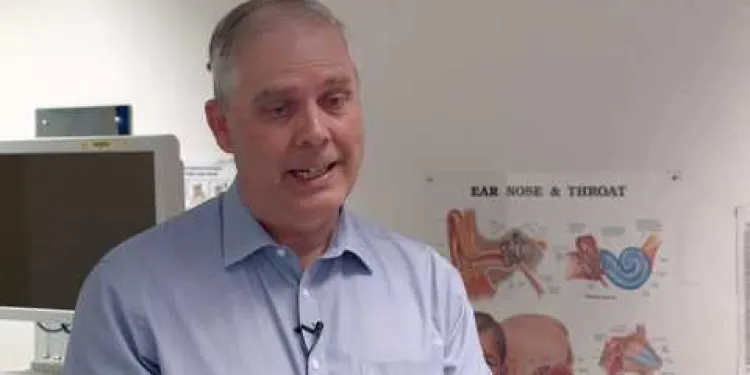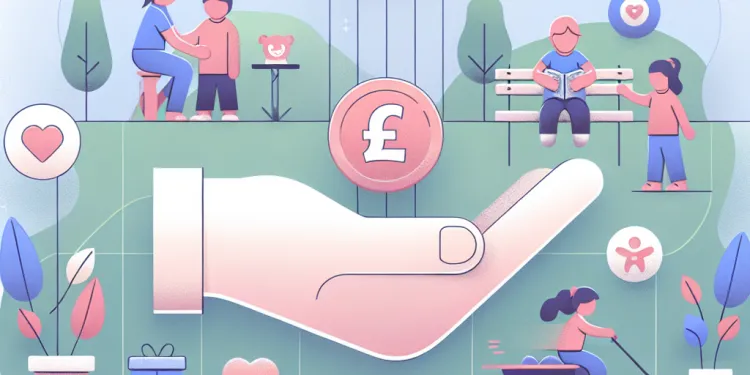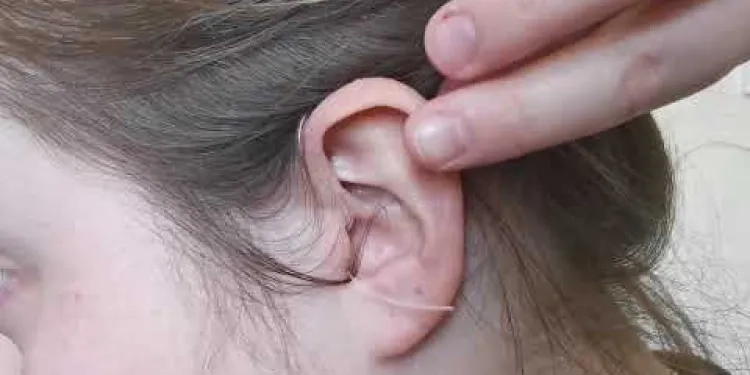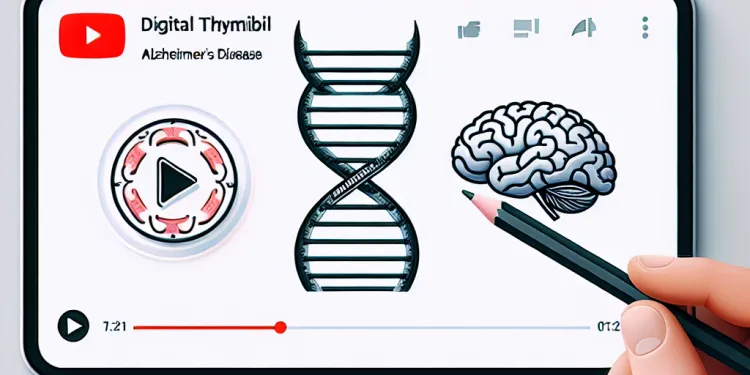Find Help
More Items From Ergsy search
-

Glue Ear Pathway
Relevance: 100%
-

Evidence-Based Interventions: grommets for glue ear in children
Relevance: 61%
-

Early onset dementia | NHS
Relevance: 22%
-

Self care: Treating ear infections
Relevance: 21%
-

Can I end a lease agreement early?
Relevance: 21%
-

Living with early stage kidney disease
Relevance: 21%
-

How can early intervention help children with autism?
Relevance: 19%
-

Prostate cancer symptoms - detecting them early
Relevance: 19%
-

What provisions are there for firefighters who retire early by choice?
Relevance: 19%
-

What should I do if I start bleeding during early pregnancy? | NHS
Relevance: 18%
-

Can retired firefighters access their pension early on the grounds of ill-health?
Relevance: 18%
-

Are there any early warning signs of a heart attack?
Relevance: 13%
-

Is there a minimum age requirement to start nurse training?
Relevance: 12%
-

Can I become a nurse in the NHS with a nursing diploma?
Relevance: 10%
-

Enhanced Recovery - Hip
Relevance: 10%
-

Parkinson’s Disease and NHS RightCare: Long Term Condition Scenario
Relevance: 10%
-

NHS-led Provider Collaboratives: improving mental health, learning disability and autism services
Relevance: 9%
-

What are the career progression opportunities for NHS nurses?
Relevance: 8%
-

What do nits look like?
Relevance: 8%
-

What are the basic educational requirements to become an NHS nurse?
Relevance: 8%
-

NHS RightCare Scenario: Sepsis
Relevance: 8%
-

What GCSEs or A-Levels do I need to become a nurse?
Relevance: 8%
-

How to treat earache | NHS
Relevance: 8%
-

Can ADHD be inherited?
Relevance: 8%
-

What can cause autism, if not paracetamol?
Relevance: 7%
-

What research is being done on Huntington's disease?
Relevance: 7%
-

Can bowel cancer spread to other parts of the body?
Relevance: 7%
-

The NHS Long Term Plan for learning disability and autism
Relevance: 7%
-

Should someone with postnatal depression seek professional help?
Relevance: 6%
-

Are inhalers the only treatment for asthma?
Relevance: 6%
-

What are systemic medications for psoriasis?
Relevance: 6%
-

Can adults have autism?
Relevance: 6%
-

What advancements have been made in understanding the bubonic plague?
Relevance: 6%
-

How does leaving the fire service before pension age affect my benefits?
Relevance: 6%
-

How does GLP-1 affect appetite?
Relevance: 6%
-

How to insert your hearing aid
Relevance: 6%
-

What role does genetics play in Alzheimer's disease?
Relevance: 6%
-

How is ketamine different from traditional antidepressants?
Relevance: 6%
-

What role do genetics play in motor neurone disease?
Relevance: 6%
-

When is the best time to get the winter flu jab?
Relevance: 6%
Understanding the Glue Ear Pathway
What is Glue Ear?
Glue ear, also known as otitis media with effusion (OME), is a common condition where the middle ear becomes filled with a sticky, glue-like fluid. This can affect hearing and is particularly prevalent among children. In the UK, it is one of the leading causes of hearing problems in young children.Causes of Glue Ear
The exact cause of glue ear is not always clear, but it often follows an ear infection or occurs when the Eustachian tube, which connects the middle ear to the back of the nose, becomes blocked or doesn't function properly. Allergies, colds, sinus infections, and family history can also be contributing factors.Symptoms of Glue Ear
The primary symptom of glue ear is a mild hearing loss. This can make it difficult for children to follow conversations, particularly in noisy environments. Other symptoms may include earache, a feeling of fullness in the ear, and balance problems. It's important for parents to notice these signs early and seek medical advice.Diagnosis of Glue Ear
Diagnosing glue ear typically involves a physical examination by a GP or an ENT (Ear, Nose, and Throat) specialist. Additionally, a tympanometry test, which measures how the eardrum responds to changes in air pressure, may be used to confirm the presence of fluid. A hearing test might also be conducted to assess the extent of hearing loss.Treatment Options for Glue Ear
Initial treatment often involves observation, as many cases resolve on their own without intervention. For persistent cases, options may include: - **Antibiotics:** If an infection is present. - **Autoinflation:** Using a special balloon to open the Eustachian tube. - **Hearing aids:** To manage hearing loss temporarily. - **Grommets (Tympanostomy tubes):** Small tubes inserted into the eardrum to drain fluid and ventilate the middle ear.Preventing Glue Ear
While it may not always be possible to prevent glue ear, following these tips can reduce the risk: - Keep children's vaccinations up to date. - Encourage regular hand washing to prevent infections. - Avoid exposure to cigarette smoke. - Promote good nasal hygiene by teaching children to blow their noses gently.When to Seek Help
If you suspect your child has glue ear, it's important to consult with a healthcare professional. Early diagnosis and treatment can help prevent long-term hearing problems and ensure your child’s development and learning are not adversely affected. By understanding the glue ear pathway, parents and caregivers can take proactive steps to manage and treat this common condition, ensuring better ear health for their children.Understanding the Glue Ear Pathway
What is Glue Ear?
Glue ear, medically known as otitis media with effusion, is a common condition where the middle ear fills with a sticky, glue-like fluid. This can lead to hearing problems because the fluid interferes with the proper movement of the eardrum and ossicles (tiny bones in the middle ear). It most frequently affects children but can occur in adults as well.
Recognising the Symptoms
Symptoms of glue ear can be subtle, making them easy to overlook. Common signs include hearing difficulties, a sense of fullness in the ear, balance issues, and intermittent ear pain. In children, it may manifest as inattentiveness, difficulty with speech and language development, and behavioural problems related to mishearing.
Diagnosis in the United Kingdom
Diagnosis often involves an initial consultation with a general practitioner (GP) who may perform a physical examination using an otoscope to look into the ear. If glue ear is suspected, particularly if the condition persists for more than three months, the GP might refer the patient to an ear, nose, and throat (ENT) specialist. Audiometry tests, tympanometry, and a thorough examination of the ear can confirm the diagnosis.
Treatment Options
In many cases, glue ear resolves on its own without the need for treatment. Thus, the initial approach may simply involve monitoring the condition. For persistent cases, treatment options in the UK include the use of hearing aids, autoinflation (using a device to help open the Eustachian tube), and the surgical insertion of grommets (tiny tubes) to ventilate the middle ear and allow fluid to drain. Adenoidectomy, the removal of adenoids, may also be considered if repeated infections are a factor.
Support and Follow-Up
Ongoing monitoring by the GP or ENT specialist is essential to ensure the condition improves. For children, hearing tests and speech therapy might be recommended if hearing impairment affects language development. Support groups and informational resources from institutions like the National Deaf Children’s Society can provide additional help for families navigating glue ear.
Preventive Measures
Preventive measures include avoiding exposure to tobacco smoke, managing allergies, and ensuring good ear hygiene. Keeping up to date with vaccinations can also help in reducing the incidence of ear infections that may lead to glue ear. While not all cases are preventable, these steps can mitigate the risk and frequency of occurrences.
Understanding Glue Ear
What is Glue Ear?
Glue ear is when sticky fluid fills the middle ear. This makes it hard to hear. It happens a lot in children. In the UK, many young children have this hearing problem.What Causes Glue Ear?
We don’t always know why glue ear happens. It can happen after an ear infection. The Eustachian tube, which goes from the ear to the back of the nose, might get blocked. Allergies, colds, sinus infections, and family history can also cause glue ear.Symptoms of Glue Ear
The main symptom is not hearing well. This makes it hard for children to follow conversations, especially when it’s noisy. Other symptoms are earache, feeling like the ear is full, and balance problems. Parents should watch for these signs and see a doctor if needed.How Do Doctors Find Glue Ear?
Doctors look in the ear and might do a hearing test. A special test called a tympanometry checks if the eardrum moves right. This helps find fluid in the ear.How is Glue Ear Treated?
Sometimes, glue ear gets better on its own. If not, treatment options include: - **Antibiotics:** If there’s an infection. - **Autoinflation:** Using a balloon to open the ear tube. - **Hearing aids:** To help hear better for a while. - **Grommets (Tympanostomy tubes):** Small tubes put in the eardrum to let the fluid out.How to Help Prevent Glue Ear
You can't always stop glue ear, but these tips can help: - Keep up with vaccinations. - Wash hands often to stop infections. - Keep away from cigarette smoke. - Teach children to blow their noses gently.When to Get Help
If you think your child has glue ear, see a doctor. Early treatment can stop long-term hearing issues. It can help your child’s learning and development. Knowing about glue ear means parents and caregivers can help manage it. This keeps children’s ears healthy.Understanding the Glue Ear Pathway
What is Glue Ear?
Glue ear is when sticky fluid fills the middle ear. It can make hearing hard. This happens because the fluid stops the ear parts from working well. Glue ear mostly happens to children but can happen to adults too.
Recognising the Symptoms
Signs of glue ear can be hard to see. Common signs are trouble hearing, feeling of full ears, trouble with balance, and ear pain that comes and goes. In children, it might show up as not paying attention, problems with talking, and behavior issues because they can't hear well.
Diagnosis in the United Kingdom
A doctor will first check you to find out if you have glue ear. They will look in your ear with a special tool called an otoscope. If glue ear is found or lasts more than three months, the doctor might send you to a specialist. Tests like audiometry (hearing test) and tympanometry (ear pressure test) can help confirm glue ear.
Treatment Options
Glue ear often gets better by itself without any treatment. Doctors may just watch and wait. If glue ear stays, treatments in the UK can include hearing aids, a special blowing device to open the ear, or tiny tubes called grommets put in the ear to let the fluid out. Sometimes, removing adenoids is also an option if infections keep happening.
Support and Follow-Up
It is important to keep checking glue ear with your doctor to make sure it gets better. For children, hearing tests and help with speaking might be necessary if hearing issues affect them. Support groups and resources like the National Deaf Children’s Society can help families dealing with glue ear.
Preventive Measures
To help prevent glue ear, avoid cigarette smoke, manage allergies, and keep ears clean. Keeping up with vaccines can also reduce ear infections that cause glue ear. These steps won't stop all glue ear but can make it happen less often.
Frequently Asked Questions
What is glue ear?
Glue ear, medically referred to as otitis media with effusion (OME), is a condition in which the middle ear becomes filled with a sticky, glue-like fluid instead of air.
What causes glue ear?
Glue ear can be caused by a variety of factors, including allergies, infections, and Eustachian tube dysfunction. It is most common in children but can also affect adults.
What are the symptoms of glue ear?
Symptoms include muffled hearing, ear pain, a feeling of fullness in the ear, balance problems, and sometimes delayed speech development in children.
How is glue ear diagnosed?
Glue ear is typically diagnosed through a combination of a medical history review, physical examination, and tests such as tympanometry and audiometry.
What treatments are available for glue ear?
Treatment options may include watchful waiting, hearing aids, autoinflation, or surgical intervention such as grommet (ventilation tube) insertion.
When should I seek medical advice for glue ear?
You should consult a healthcare professional if symptoms persist for more than a few weeks, if there is significant hearing loss, or if it is affecting your child’s development.
Can glue ear resolve on its own?
Yes, in many cases glue ear can resolve on its own within a few months. However, persistent cases may require medical intervention.
Are there any complications associated with glue ear?
Complications can include persistent hearing loss, recurrent ear infections, and in severe cases, permanent damage to the ear structures.
Can adults get glue ear?
Yes, while it is more common in children due to their narrower Eustachian tubes, adults can still develop glue ear.
Is glue ear infectious?
Glue ear itself is not infectious, but it can follow an upper respiratory infection, which is contagious.
What are grommets and how do they help?
Grommets are tiny tubes surgically inserted into the eardrum to allow air to enter the middle ear and fluid to drain, helping to alleviate glue ear.
How long do grommets stay in place?
Grommets usually stay in place for 6 to 12 months before falling out naturally. The ear drum typically heals on its own after they fall out.
Can glue ear affect a child’s speech development?
Yes, persistent glue ear can lead to temporary hearing loss, which may interfere with a child’s speech and language development.
Is there anything I can do at home to help with glue ear?
Autoinflation techniques, such as the use of nasal balloons, can sometimes help by opening the Eustachian tube to allow fluid to drain from the middle ear.
Does diet affect glue ear?
There is limited evidence to suggest that diet directly affects glue ear, though overall good nutrition supports immune health and may help reduce the risk of infections that can lead to glue ear.
What is glue ear?
Glue ear is a condition where the middle ear becomes filled with fluid, leading to hearing problems. It's common in young children and can cause temporary hearing loss.
What causes glue ear?
Glue ear is often caused by a blockage in the Eustachian tube, which can happen due to infections, allergies, or other factors that cause inflammation in the ear.
What are the symptoms of glue ear?
Symptoms of glue ear include hearing loss, earache, difficulty with balance, and sometimes a feeling of fullness or pressure in the ear.
How is glue ear diagnosed?
Diagnosis is typically done by a GP or a specialist using a combination of hearing tests and examinations of the ear, sometimes involving an otoscope or a tympanometry.
Who is most at risk for glue ear?
Children between the ages of two and six are most at risk for glue ear, although it can occur at any age.
Can glue ear affect speech development?
Yes, prolonged hearing loss due to glue ear can affect a child's speech and language development.
What treatments are available for glue ear?
Treatment options include watchful waiting, use of hearing aids, or surgical intervention such as the insertion of grommets (tiny tubes) to drain fluid from the middle ear.
Is glue ear contagious?
No, glue ear itself is not contagious, although the infections that may cause it can be.
Can adults get glue ear?
Yes, while glue ear is more common in children, adults can also develop the condition.
How long does glue ear typically last?
Glue ear often resolves on its own within a few months, but in some cases, it can persist and require treatment.
Will my child need surgery for glue ear?
Not always. Many cases of glue ear resolve on their own. Surgery, such as grommet insertion, is considered if the condition persists and significantly affects hearing and quality of life.
Can glue ear be prevented?
There is no sure way to prevent glue ear, but reducing exposure to colds and infections, avoiding smoking around children, and ensuring good general ear hygiene can help reduce risk.
What should I do if I suspect my child has glue ear?
If you suspect your child has glue ear, contact your GP for an evaluation. Early diagnosis and management can help mitigate potential complications.
Are there any complications associated with glue ear?
If untreated, glue ear can lead to persistent hearing problems and affect speech and learning development in children. Chronic cases can also lead to ear infections.
What follow-up care is required after treatment for glue ear?
Follow-up care usually includes regular hearing tests to ensure that hearing is restored and monitoring for any recurrence of the condition. Your GP or specialist will advise on a suitable schedule.
What is glue ear?
Glue ear is when sticky stuff builds up in your ear. It can make it hard to hear.
Here are some tools that might help:
- Use pictures to understand better.
- Ask a grown-up to explain it to you.
- Watch videos about glue ear.
Glue ear is when the middle ear fills up with sticky fluid. Usually, it should have air in it.
Why do people get glue ear?
Glue ear happens when stuff builds up behind the ear, making it hard to hear. This can happen because of allergies, infections, or problems with the Eustachian tube, which helps ears stay healthy. It happens mostly in kids but can happen to adults too.
What happens when you have glue ear?
You might notice these signs:
- Your hearing sounds fuzzy or quiet.
- Your ear hurts.
- Your ear feels like it is full.
- You may feel off balance.
- For kids, learning to talk might be slower.
Try using pictures or signs to help understand and remember these signs better.
How do doctors find out if someone has glue ear?
The doctor can tell if you have glue ear by asking questions about your health, checking your ears, and doing special tests. These tests are called tympanometry and audiometry.
If reading is hard, try using tools like audiobooks to hear the information. A family member or friend can read with you and help explain things.
What can help with glue ear?
Glue ear is when your ear is full of sticky stuff. This can make it hard to hear.
Here are some things that might help:
- Watch and wait: Sometimes glue ear gets better on its own.
- Hearing aids: These help you hear better if glue ear is a problem.
- Grommets: Doctors can put tiny tubes in your ear to let air in. This helps clear the sticky stuff.
- Nasal spray: This can help if you also have a blocked nose.
If you're worried, talk to a doctor. They will know what is best.
Treatment choices can be:
- Waiting and checking to see if it gets better by itself.
- Using hearing aids to help you hear better.
- Blowing up a balloon with your nose and mouth to help your ears pop. This is called autoinflation.
- Surgery to put a small tube in your ear. This tube helps air go in and out. It is called a grommet.
You can ask a doctor for more advice. They can help you pick the best treatment. Using pictures and videos might help you understand better. You can also talk to someone who has been through this before.
When should I ask a doctor for help with glue ear?
Talk to a doctor if your symptoms do not go away after a few weeks. Also, if you have trouble hearing or if it is stopping your child from growing and learning, see a doctor too.
Can glue ear get better by itself?
Glue ear is when there is a sticky liquid inside your ear. This can make it hard to hear.
Sometimes, glue ear can get better without any help.
If you are worried, it's a good idea to see a doctor.
You can also try these things to help:
- Keep your ears dry and clean.
- Avoid smoking or smoky areas.
- Try blowing balloons to help your ears.
Remember, if you are not sure, always ask a grown-up or doctor for help!
Yes, sometimes glue ear gets better by itself in a few months. But if it doesn't, a doctor might need to help.
Can glue ear cause problems?
Sometimes, problems can happen. These problems might be losing your hearing for a long time, getting ear infections again and again, or, in really bad cases, hurting parts of your ear forever.
If you have trouble reading, try using tools like audiobooks to listen instead. You can also ask someone to read with you or look for books with pictures to help understand the story better.
Can grown-ups have glue ear?
Yes, grown-ups can get glue ear, but it happens more often in kids.
Glue ear is when stuff gets stuck in your ear and makes it hard to hear.
If you think you have glue ear, tell a doctor. They can help you feel better.
For more help, use tools like using pictures or talking slowly.
To make reading easier, you can also listen to someone read out loud to you.
Yes, adults can get glue ear too, even though kids get it more. This is because kids have smaller ear tubes.
Can you catch glue ear from someone else?
Glue ear is not something you can catch from someone else.
But it can happen after a cold or a sore throat, which can be caught from others.
What Are Grommets and How Do They Help?
Grommets are tiny tubes that go into the ear. They help children hear better.
Sometimes, kids get fluid stuck in their middle ear. This makes it hard to hear. Grommets help get the air to move in and out, which makes the fluid go away.
Doctors put grommets in during a small operation. It doesn't hurt because you are asleep. Grommets usually stay in the ear for about 6 to 12 months, and then they fall out on their own.
If you find it hard to read, try listening to this using a text-to-speech tool. Asking a friend or an adult to read and explain can also help.
Grommets are little tubes put into the eardrum during an operation. They let air in and help drain fluid from the middle ear. This helps with glue ear.
How long do grommets stay in your ear?
Grommets stay in your ear for 6 to 12 months. They fall out by themselves. After they fall out, the ear heals by itself.
Can glue ear change how a child talks?
Glue ear can make it hard for kids to hear. Good hearing helps kids learn to talk. If they can't hear well, they might have trouble talking.
To help, you can:
- Visit a doctor to check their ears.
- Use pictures or gestures to help them understand.
- Read and talk with the child often.
These steps can help kids with glue ear learn to talk better.
Yes, glue ear can make it hard for a child to hear. This can make learning to talk and understand words harder.
What can I do at home to help with glue ear?
Do you want to help someone with glue ear? There are things you can try at home!
You can keep loud sounds away. This helps the ears to rest.
Reading together is good. It helps to talk clearly and listen.
Try rhymes or songs. This can make hearing fun!
If you are worried, talk to a doctor. They can help too.
Use picture books or videos. These help explain things better.
Blowing up special nose balloons can help ears get better. It helps open a little tube in the ear. This lets the extra liquid come out from behind the ear.
Does what you eat change glue ear?
Glue ear is when your ear gets blocked. Can the food you eat make glue ear better or worse?
If you want to know more, you can:
- Ask a doctor
- Use online videos
- Or talk to someone who has had glue ear
We don't have a lot of proof, but what you eat doesn't seem to change glue ear. Eating healthy food is good for your body and can help keep you from getting sick, which might stop glue ear from happening.
What is glue ear?
"Glue ear" means having thick, sticky liquid in your ear. It can make it hard to hear properly.
Doctors can help check your ears. They might give you special medicine or suggest small tubes to help you hear better.
If you have problems hearing, try using pictures, watching videos with subtitles, or asking someone to speak slowly and clearly.
Glue ear is when fluid gets in the middle part of the ear. This can make it hard to hear. It happens a lot to young kids and can cause hearing problems for a little while.
What makes glue ear happen?
Glue ear is when sticky stuff builds up in your ear. This can make it hard to hear.
Here are some things that can cause glue ear:
- Having a cold or ear infection
- Allergies like hay fever
- Being around smoke
- Drinking from a bottle while lying down (for babies)
If you think you have glue ear, it's good to talk to a doctor. They can help you feel better.
Helpful tools:
- Hearing aids or special devices can make sounds louder.
- Speech therapy can help with talking and listening.
- Visual aids, like pictures, can help explain things.
Glue ear happens when the Eustachian tube gets blocked. This can happen because of infections, allergies, or when the ear gets swollen.
What are the signs of glue ear?
Glue ear can make it hard to hear.
Here are some signs:
- Ear hurts.
- You can't hear well.
- Ear feels full or blocked.
- Can't pay attention.
Tools to help:
- Watch TV with captions.
- Use a hearing aid if needed.
- See a doctor if it doesn't get better.
Glue ear can make it hard to hear. Your ear might hurt. You might feel wobbly or off-balance. Sometimes, your ear can feel full or like there is pressure inside.
How do doctors find out if you have glue ear?
Doctors use tests to see if you have glue ear. They look in your ear with a special light. This is called an otoscope. They listen to how you hear sounds. If needed, doctors can do a test called a tympanometry. This test checks the pressure in your ear.
If you think you have glue ear, tell a doctor. Getting checked early is helpful. A parent, friend, or carer can come with you to help understand the doctor. Taking notes can help you remember what the doctor says.
A doctor checks your hearing to understand if there is a problem. They use special tools to look in your ear. Sometimes, they use a tool called an otoscope or try a test called tympanometry.
Who can get glue ear more easily?
Some kids can get glue ear more often than others. Here is who might get it more:
- Young children: Glue ear is more common in kids aged 2 to 5.
- Frequent colds: Kids who often catch colds may get glue ear.
- Family history: If someone in the family had glue ear, a child might get it too.
- Second-hand smoke: Being around cigarette smoke can make glue ear happen more.
- Allergies: Kids with allergies might have a higher chance of glue ear.
Parents and guardians can:
- Make sure kids wash their hands to avoid colds.
- Keep them away from cigarette smoke.
- Visit the doctor regularly for check-ups.
Children who are 2 to 6 years old can get glue ear the most. But people of any age can have it too.
Can glue ear change how we learn to talk?
Glue ear can make it hard to hear well.
When we can't hear, it can be hard to learn new words.
This might change how we learn to talk.
If you think you have glue ear, here are some things you can try:
- Speak to a doctor.
- Use pictures to help understand words.
- Play listening games.
Yes, having hearing problems for a long time because of glue ear can make it harder for a child to learn to talk and understand words.
What can help with glue ear?
Glue ear means there is thick fluid in the ear. It can make it hard to hear.
Here are some things that might help:
- Waiting: Sometimes, glue ear gets better on its own.
- Ear tubes: A doctor can put small tubes in the ears. This helps the fluid drain away.
- Hearing aids: These make sounds louder.
- Nose spray: A spray for the nose might help some children.
If you think your child has glue ear, talk to a doctor. They can help you find the best way to help your child.
There are different ways to help:
- You can wait and see if things get better on their own.
- You can use hearing aids to help you hear better.
- Doctors can do a small surgery. They put tiny tubes, called grommets, in your ear. These tubes help drain fluid from your middle ear.
If you need help understanding, ask a doctor or a trusted adult. They can explain more and help you decide what to do.
Can you catch glue ear from someone else?
No, glue ear is not something you can catch from another person. It is not like a cold or the flu.
Glue ear happens when there is sticky fluid in the ear. It can make it hard to hear.
Talk to a doctor if you think you have glue ear. They can help.
Using headphones or listening devices can help with hearing. Ask a grown-up to help you find the right ones.
No, glue ear cannot be spread from one person to another. But, the germs that can lead to glue ear might be contagious.
You can stay safe by washing your hands often and avoiding close contact with sick people.
Can grown-ups get glue ear?
Yes, grown-ups can get glue ear, but it is more common in children.
Glue ear happens when the middle part of the ear fills with fluid. This can make hearing hard.
If you think you have glue ear, you should see a doctor. They can help you feel better.
It can help to use a calendar to track when your ears hurt. That way, you can tell the doctor.
Yes, adults can get glue ear too, even though it happens more often in children.
How long does glue ear usually last?
Glue ear is when sticky stuff builds up in the ear.
Most of the time, it goes away by itself in about 3 months.
Reading tools, like audiobooks, can help you understand more about glue ear.
Glue ear usually gets better by itself in a few months. Sometimes, it sticks around and needs help to get better.
Does my child need an operation for glue ear?
Glue ear does not always need an operation. It often gets better on its own. If it doesn't, and it makes hearing hard and life not fun, doctors might suggest putting in small tubes called grommets to help.
If you find reading hard, ask someone to read to you or use apps that can read aloud. Drawing pictures of what you read can also help you understand better.
How can you stop glue ear?
Glue ear is when the ear fills with sticky stuff and it's hard to hear. Here are some simple steps to help stop it:
- Wash your hands a lot to keep germs away.
- Stay away from smoky places.
- Try not to catch colds by staying warm.
- See the doctor often if you have ear problems.
If you still have trouble, you can use tools that help you understand better:
- Use pictures and drawings to show what you mean.
- A doctor can explain using simple words.
We can't totally stop glue ear, but here are some ways to help lower the risk:
- Keep kids away from colds and sickness.
- Don’t smoke near children.
- Keep ears clean and healthy.
What can I do if I think my child has glue ear?
If you think your child has glue ear, try these steps:
- Visit a doctor: The doctor can check your child's ears and help you understand what to do next.
- Watch for signs: Look for hearing problems or if your child often gets ear infections.
- Talk to teachers: Let your child's teachers know. They can help keep an eye on your child's hearing at school.
- Use big pictures: Show your child pictures and use clear, simple words to help them understand.
Remember, you are not alone. Many parents and children go through this. You can ask for help and use these tips to support your child.
If you think your child has glue ear, talk to your doctor. Getting help early can stop problems from happening later.
Can glue ear cause any problems?
If glue ear is not treated, it can cause hearing problems that don't go away. This can make it hard for kids to learn and talk clearly. Sometimes, it can also cause ear infections.
What care is needed after glue ear treatment?
After someone gets treated for glue ear, they need to keep visiting the doctor. The doctor will check their ears to make sure everything is okay.
It is important to go to these check-ups. The doctor will look at the child's hearing and ear health. This helps the doctor know if more treatment is needed.
Parents can help by keeping a note of any changes in their child's hearing. They should also tell the doctor if they notice the glue ear is coming back.
Using picture books or apps with sounds can help track hearing progress. Simple ear protection like earplugs can help keep water out of the ears during baths or swimming.
After treatment, you will need to have regular check-ups. These check-ups will include hearing tests to make sure your hearing is better. The doctor will also check if the problem comes back. Your doctor will tell you when to come back for each check-up.
Useful Links
Useful links from: Evidence-Based Interventions: grommets for glue ear in children
- NHS - Grommets for Glue Ear An overview of treatment options for glue ear including the use of grommets, provided by the National Health Service (NHS) in the UK.
- NHS Inform - Glue Ear in Children Detailed information about glue ear in children, including symptoms, causes, and treatments such as grommets, provided by NHS Inform.
- Action on Hearing Loss (RNID) - Glue Ear Comprehensive information on glue ear, its impact on hearing, and available treatments, shared by the Royal National Institute for Deaf People (RNID).
- Great Ormond Street Hospital - Grommets Insertion A resource from Great Ormond Street Hospital explaining the grommet insertion procedure for children, including what to expect and aftercare.
Useful links from: How to treat earache | NHS
- NHS - Earache Official NHS page detailing symptoms, causes, and treatments for earache, including advice on when to seek medical help.
- NHS Inform - Earache NHS Inform guide providing comprehensive information on earache, including self-care tips and potential treatment options.
- British Tinnitus Association - Ear Pain Information from the British Tinnitus Association covering causes of ear pain, including tinnitus, and advice on treatments and managing symptoms.
- Action on Hearing Loss - Ear Infections Action on Hearing Loss provides detailed information about the various types of ear infections, their symptoms, how they are diagnosed, and the treatments available.
- Ergsy carfully checks the information in the videos we provide here.
- Videos shown by Youtube after a video has completed, have NOT been reviewed by ERGSY.
- To view, click the arrow in centre of video.
- Most of the videos you find here will have subtitles and/or closed captions available.
- You may need to turn these on, and choose your preferred language.
- Go to the video you'd like to watch.
- If closed captions (CC) are available, settings will be visible on the bottom right of the video player.
- To turn on Captions, click settings .
- To turn off Captions, click settings again.
More Items From Ergsy search
-

Glue Ear Pathway
Relevance: 100%
-

Evidence-Based Interventions: grommets for glue ear in children
Relevance: 61%
-

Early onset dementia | NHS
Relevance: 22%
-

Self care: Treating ear infections
Relevance: 21%
-

Can I end a lease agreement early?
Relevance: 21%
-

Living with early stage kidney disease
Relevance: 21%
-

How can early intervention help children with autism?
Relevance: 19%
-

Prostate cancer symptoms - detecting them early
Relevance: 19%
-

What provisions are there for firefighters who retire early by choice?
Relevance: 19%
-

What should I do if I start bleeding during early pregnancy? | NHS
Relevance: 18%
-

Can retired firefighters access their pension early on the grounds of ill-health?
Relevance: 18%
-

Are there any early warning signs of a heart attack?
Relevance: 13%
-

Is there a minimum age requirement to start nurse training?
Relevance: 12%
-

Can I become a nurse in the NHS with a nursing diploma?
Relevance: 10%
-

Enhanced Recovery - Hip
Relevance: 10%
-

Parkinson’s Disease and NHS RightCare: Long Term Condition Scenario
Relevance: 10%
-

NHS-led Provider Collaboratives: improving mental health, learning disability and autism services
Relevance: 9%
-

What are the career progression opportunities for NHS nurses?
Relevance: 8%
-

What do nits look like?
Relevance: 8%
-

What are the basic educational requirements to become an NHS nurse?
Relevance: 8%
-

NHS RightCare Scenario: Sepsis
Relevance: 8%
-

What GCSEs or A-Levels do I need to become a nurse?
Relevance: 8%
-

How to treat earache | NHS
Relevance: 8%
-

Can ADHD be inherited?
Relevance: 8%
-

What can cause autism, if not paracetamol?
Relevance: 7%
-

What research is being done on Huntington's disease?
Relevance: 7%
-

Can bowel cancer spread to other parts of the body?
Relevance: 7%
-

The NHS Long Term Plan for learning disability and autism
Relevance: 7%
-

Should someone with postnatal depression seek professional help?
Relevance: 6%
-

Are inhalers the only treatment for asthma?
Relevance: 6%
-

What are systemic medications for psoriasis?
Relevance: 6%
-

Can adults have autism?
Relevance: 6%
-

What advancements have been made in understanding the bubonic plague?
Relevance: 6%
-

How does leaving the fire service before pension age affect my benefits?
Relevance: 6%
-

How does GLP-1 affect appetite?
Relevance: 6%
-

How to insert your hearing aid
Relevance: 6%
-

What role does genetics play in Alzheimer's disease?
Relevance: 6%
-

How is ketamine different from traditional antidepressants?
Relevance: 6%
-

What role do genetics play in motor neurone disease?
Relevance: 6%
-

When is the best time to get the winter flu jab?
Relevance: 6%